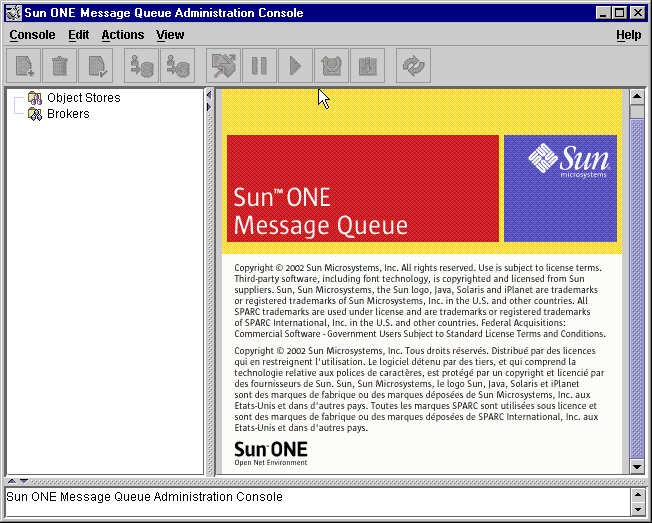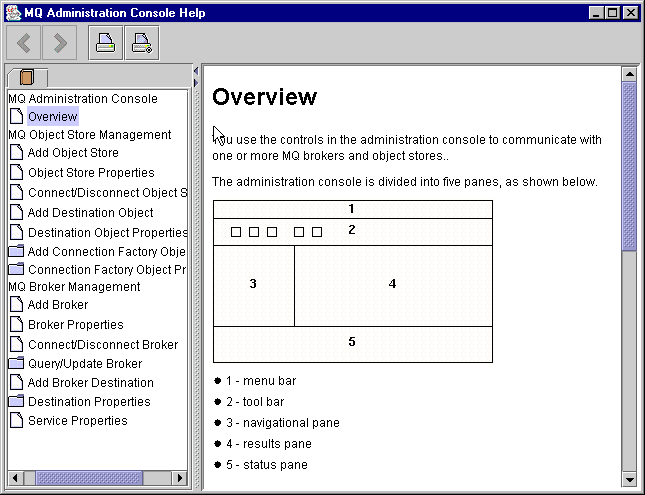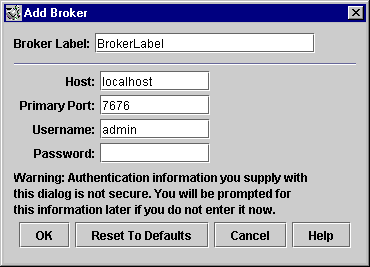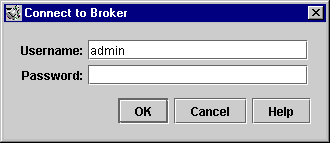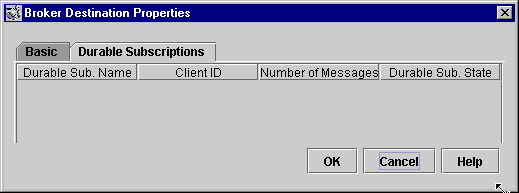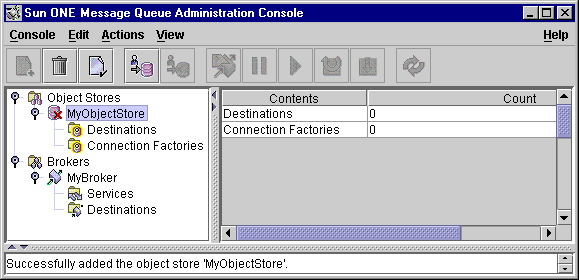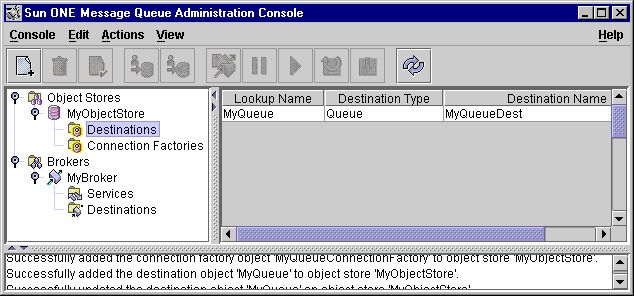|
|
| Sun ONE Message Queue Administrator's Guide |
Chapter 4 Administration Console Tutorial
This tutorial focuses on the use of the Administration Console, a graphical interface for administering an MQ message server. By following this tutorial, you will learn how to do the following:
Start a broker and use the Console to connect to it and manage it
The tutorial is designed to set up the destinations and administered objects needed to run a simple JMS-compliant application, SimpleJNDIClient. In the last part of the tutorial you run this application.Create physical destinations on the broker
This tutorial is provided mainly to guide you through performing basic administration tasks using the Administration Console. It is not a substitute for reading through the MQ Developer's Guide or other chapters of this Administrator's Guide.
Some MQ administration tasks cannot be accomplished using graphical tools; you will need to use command line utilities to perform such tasks as the following:
Configuring certain broker properties
Creating broker clusters
- Some broker properties cannot be configured using the Administration Console. These can be configured as described in Chapter 5, "Starting and Configuring a Broker" or in "Updating a Broker".
Managing a user database
- See"Working With Broker Clusters" for more information.
- See "Authenticating Users" for more information.
Getting Ready
Before you can start this tutorial you must install the MQ product. For more information, see the MQ Installation Guide. Note that this tutorial is Windows-centric, with added notes for unix users.In this tutorial, choosing Item1 > Item2 > Item3 means that you should pull down the menu called Item1, choose Item2 from that menu and then choose Item3 from the selections offered by Item2.
Starting the Administration Console
The Administration Console is a graphical tool that you use to do the following:
Create references to and connect to brokers
Create physical destinations on the brokers, which are used by the broker for message delivery
Connect to object stores in which you place MQ administered objects
- Administered objects allow you to manage the messaging needs of JMS-compliant applications. For more information, see "MQ Administered Objects".
To start the Administration Console
Choose Start > Programs > Message Queue 3.0 > Administration.
No tutorial can provide complete information, so let's first find out how to get help information for the Administration Console.
Take a few seconds to examine the Console window.
- You may need to wait a few seconds before the Console window is displayed.
- Non-Windows users: enter the following command at the command prompt:
- $IMQ_HOME/bin/imqadmin (/usr/bin/imqadmin on Solaris)
- The Console features a menu at the top, a tool bar just underneath the menu, a navigation pane to the left, a larger pane to the right (now displaying graphics identifying the Sun ONE Message Queue product), and a status pane at the bottom.
Getting Help
Locate the Help menu at the extreme right of the menu bar.
To display Administration Console help information
Pull down the Help menu and choose Overview. A help window is displayed.
Look at the Help window's contents pane. It organizes topics in three areas: overview, object store management, and broker management. Each of these areas contains files and folders. Each folder provides help for dialogs containing multiple tabs; each file provides help for a simple dialog or tab.
- Notice how the help information is organized. The left pane shows a table of contents; the right pane shows the contents of any item you select on the left.
- Look at the right pane of the Help window. It shows a skeletal view of the Administration Console, identifying the use of each of the Console's panes.
Click the Add Broker item in the Help window's contents pane.
- Your first Console administration task, "Adding a Broker", will be to create a reference to a broker you manage through the Console. Before you start, however, check the online help for information.
Read through the help text.
- Note that the contents pane has changed. It now contains text that explains what it means to add a broker and that describes the use of each field in the Add Broker dialog. Field names are shown in bold text.
Working With Brokers
A broker provides delivery services for an MQ messaging system. Message delivery is a two-phase process: the message is first delivered to a physical destination on a broker and then it is delivered to one or more consuming clients.Working with brokers involves the following tasks:
Start and configure the broker
The broker supports communication with both application clients and administration clients. It does this by means of different connection services, and you can configure the broker to run any or all of these services. For more information about connection services, see "Connection Services".
Manage the broker and its services either by using the Administration Console or by using the imqcmd command
- You can start the broker from the Start > Programs menu on Windows or by using the imqbrokerd command. If you use the imqbrokerd command, you can specify broker configuration information using command line options. If you use the Programs menu, you can specify configuration information using the Console and in other ways described in Chapter 5, "Starting and Configuring a Broker."
Create the physical destinations needed by client applications
Starting a Broker
You cannot start a broker using the Administration Console. Start the broker as described below (also, see Chapter 5 "Starting and Configuring a Broker).
Choose Start > Programs > Message Queue 3.0 > Broker.
You do not have to start the broker before you add a reference to it in the Administration Console, but you must start the broker before you can connect to it.Bring the Administration Console window back into focus. You are now ready to add the broker to the Console and to connect to it.
Adding a Broker
Adding a broker creates a reference to that broker in the Administration Console. After adding the broker, you can connect to it.
To add a broker to the Administration Console
Right-click on Brokers in the navigation pane and choose Add Broker.
Enter MyBroker in the Broker Label field.
Click OK to add the broker.
- This provides a label that identifies the broker in the Administration Console.
- Note the default host name (localhost) and primary port (7676) specified in the dialog. These are the values you will need to specify later, when you configure the connection factory that the client will use to set up connections to this broker.
- Leave the Password field blank. Your password will be more secure if you specify it at connection time.
Right-click on MyBroker and choose Properties from the popup menu.
- Look at the navigation pane. The broker you just added should be listed there under Brokers. The red X over the broker icon tells you that the broker is not currently connected to the Console.
- The broker properties dialog is displayed. You can use this dialog to update any of the properties you specified when you added the broker.
Changing the Administrator Password
When you connect to the broker, you are prompted for a password if you have not specified one when you added the broker. For improved security, it's a good idea to change the default administrator password (admin) before you connect.
To change the administrator password
Open a command-prompt window or, if one is already opened, bring it forward.
The change takes effect immediately. You must then specify the new password whenever you use one of the MQ command line utilities or the Administration Console.Enter a command like the following, substituting your own password for abracadabra. The password you specify then replaces the default password of admin.
- imqusermgr update -u admin -p abracadabra
- (On Solaris and Linux, you must be root to perform this operation.)
Although clients use a different connection service than administrators, they are also assigned a default user name and password so that you can test MQ without having to do extensive administrative set up. By default, a client can connect to the broker as user guest with the password guest. You should, however, establish secure user names and passwords for clients as soon as you can. See "Authenticating Users" for more information.
Right-click MyBroker and choose Connect to Broker.
After you connect to the broker, you can choose from the Actions menu to get information about the broker, to pause and resume the broker, to shutdown and restart the broker, and to disconnect from the broker.Enter admin in the Password field or whatever value you specified for the password in "Changing the Administrator Password".
Click OK to connect to the broker.
- Specifying the user name admin and supplying the correct password connects you to the broker, with administrative privileges.
Viewing Connection Services
A broker is distinguished by the connection services it provides and the physical destinations it supports.
To view available connection services
Select Services in the navigation pane.
Select the jms service by clicking on it in the results pane.
- Available services are listed in the results pane. For each service, its name, port number, and state is provided.
Pull down the Actions menu and note the highlighted items.
Choose Properties from the Actions menu.
- You have the option of pausing the jms service or of viewing and updating its properties.
Click OK or Cancel to close the Properties dialog.
- Note that by using the Service Properties dialog, you can assign the service a static port number and you can change the minimum and maximum number of threads allocated for this service.
Select the admin service in the results pane.
Choose Actions > Properties to view the properties of the admin service.
- Notice that you cannot pause this service (the pause item is disabled). The admin service is the administrator's link to the broker. If you paused it, you would no longer be able to access the broker.
Adding Physical Destinations to a Broker
You must explicitly create physical destinations on the broker so that JMS-compliant applications can run properly. You do not need to do this if the broker has destination auto-creation enabled, which allows it to create physical destinations dynamically.Destination auto-creation is acceptable in a development environment. However, in a production setting, it is advisable to turn it off and have the broker use physical destinations that you have explicitly created. This allows you, the administrator, to be fully aware of the destinations that are in use on the broker.
You control whether the broker can add auto-created destinations by setting the imq.autocreate.topic or imq.autocreate.queue properties. For more information, see "Auto-Created (vs. Admin-Created) Destinations".
In this section of the tutorial, you will add a physical destination to the broker. You should note the name you assign to the destination; you will need it later when you create an administered object that corresponds to this physical destination.
To add a queue destination to a broker
Right-click the Destinations node of MyBroker and choose Add Broker Destination.
Enter MyQueueDest in the Destination Name field.
Select the Queue radio button if it is not already selected.
Make sure the Queue Delivery Policy is selected as Single.
Click OK to add the physical destination.
- The destination now appears in the results pane.
Working With Physical Destinations
Once you have added a physical destination on the broker, you can do any of the following tasks, as described in the procedures below:
To view the properties of a physical destination
Select the Destinations node of MyBroker.
Select MyQueueDest in the results pane.
Click Cancel to close the dialog.
To purge messages from a destination
Select the physical destination in the Results pane.
Purging messages removes the messages and leaves an empty destination.Choose Actions > Purge Messages.
- A confirmation dialog is displayed.
Deleting a destination purges the messages at that destination and removes the destination.
Getting Information About Topic Destinations
The dialog about topic destinations includes an additional tab that lists information about durable subscriptions.
purge durable subscriptions, removing all messages associated with a durable subscription
delete durable subscriptions, purging all messages associated with a durable subscription and also removing the durable subscription
Working with Object Stores
An object store, be it an LDAP directory server or a file system store (directory in the file system), is used to store MQ administered objects that encapsulate MQ-specific implementation and configuration information about objects that are used by client applications.Although administered objects can be instantiated and configured within client code, it is preferable that you, the administrator, create and configure these objects and store them in an object store that is accessed by client applications through standard JNDI lookup code. This allows client code to be provider-independent.
For more information about administered objects, see "MQ Administered Objects".
You cannot use the Administration Console to create an object store. You must do this ahead of time as described in the following section.
Adding an Object Store
Adding an object store creates a reference to an existing object store in the Administration Console. This reference is retained even if you quit and restart the Console.
To add a file-system object store
If you do not already have a folder named Temp on your C drive, create it now.
Right-click on Object Stores and choose Add Object Store.
- The sample application used in this tutorial assumes that the object store is a folder named Temp on the C drive. In general, a file-system object store can be any directory on any drive.
- Non-Windows: you can use the /tmp directory, which should already exist.
Enter MyObjectStore in the field named ObjectStoreLabel.
From the Name pull-down menu, choose java.naming.factory.initial.
- This simply provides a label for the display of the object store in the Administration Console.
- In the following steps, you will need to enter JNDI name/value pairs. These pairs are used by JMS-compliant applications for looking up administered objects.
In the Value field, enter the following
- This property allows you to specify what JNDI service provider you wish to use. For example, a file system service provider or an LDAP service provider.
- com.sun.jndi.fscontext.RefFSContextFactory
Click the Add button.
- This means that you will be using a file system store. (For an LDAP store, you would specify com.sun.jndi.ldap.LdapCtxFactory.)
- In a production environment, you will probably want to use an LDAP directory server as an object store. For information about setting up the server and doing JNDI lookups, see "Object Store Attributes".
From the Name pull down menu, choose java.naming.provider.url.
- Notice that the property and its value are now listed in the property summary pane.
In the Value field, enter the following
- This property allows you to specify the exact location of the object store. For a file system type object store, this will be the name of an existing directory.
Click the Add button.
- file:///C:/Temp
- Non-windows: specify file:///tmp
Click OK to add the object store.
- Notice that both properties and their values are now listed in the property summary pane. If you were using an LDAP server, you might also have to specify authentication information; this is not necessary for a file-system store.
If the node MyObjectStore is not selected in the navigation pane, select it now.
- The Administration Console now looks like this:
- The object store is listed in the navigation pane and its contents, Destinations and Connection Factories, are listed in the results pane. We have not yet added any administered objects to the object store, and this is shown in the Count column of the results pane.
- A red X is drawn through the object store's icon in the navigation pane. This means that it is disconnected. Before you can use the object store, you will need to connect to it.
Checking Object Store Properties
While the Administration Console is disconnected from an object store, you can examine and change some of the properties of the object store.
To display the properties of an object store
Right click on MyObjectStore in the navigational pane.
Choose Properties from the popup menu.
Click OK or Cancel to dismiss the dialog.
- A dialog is displayed that shows all the properties you specified when you added the object store. You can change any of these properties and click OK to update the old information.
Connecting to an Object Store
Before you can add objects to an object store, you must connect to it.
Right click on MyObjectStore in the navigational pane.
Choose Connect to Object Store from the popup menu.
- Notice that the object store's icon is no longer crossed out. You can now add objects, connection factories and destinations, to the object store.
Adding a Connection Factory
Administered Object
You can use the administration console to create and configure a connection factory. A connection factory is used by client code to connect to the broker. By configuring a connection factory, you can control the behavior of the connections it is used to create.For information on configuring connection factories, see the online help and the MQ Developer's Guide.
To add a connection factory to an object store
If not already connected, connect to MyObjectStore (see "Connecting to an Object Store")
Right click on the Connection Factories node and choose Add Connection Factory Object.
Enter the name "MyQueueConnectionFactory" in the LookupName field.
Select the QueueConnectionFactory from the pull-down menu to specify the type of the connection factory.
- This is the name that the client code uses when it looks up the connection factory as shown in the following line from SimpleAdmin.java:
- qcf=(javax.jms.QueueConnectionFactory)
ctx.lookup("MyQueueConnectionFactory")
Enter the host name and port for the broker to which the client is planning to connect, in the Broker Host Name and Broker Host Port fields.
Click through the tabs for this dialog to see the kind of information that you can configure for the connection factory. Use the Help button in the lower right hand corner of the Add Connection Factory Object dialog to get information about individual tabs. Do not change any of the default values for now.
- In this tutorial, the client connects to the default broker--that is, a broker on localhost at port 7676, so you do not have to change these fields.
Click OK to create the queue connection factory.
Look at the results pane: the lookup name and type of the newly created connection factory are listed.
Adding a Destination Administered Object
Destination administered objects are associated with physical destinations on the broker; they point to those destinations, as it were, allowing clients to look up and find physical destinations, independently of the provider-specific ways in which those destinations are named and configured.When a JMS client sends a message, it looks up (or instantiates) a destination administered object and references it in the send() method of the JMS API. The broker is then responsible for delivering the message to the physical destination that is associated with that administered object:
If you have created a physical destination that is associated with that administered object, the broker delivers the message to that physical destination.
In the next part of the tutorial, you will be adding an administered object that corresponds to the physical destination you added earlier.If you have not created a physical destination and the autocreation of physical destinations is enabled, the broker itself creates the physical destination and delivers the message to that destination.
If you have not created a physical destination and the autocreation of physical destinations is disabled, the broker cannot create a physical destination and cannot deliver the message.
To add a destination to an object store
Right-click on the Destinations node in the navigation pane.
Choose Add Destination Object.
Enter "MyQueue" in the Lookup Name field.
- The Administration Console displays an Add Destination Object dialog that you use to specify information about the object.
Select the Queue radio button for the Destination Type.
- The lookup name is used to find the object using JNDI lookup calls. In the sample application, the call is the following:
- queue=(javax.jms.Queue)ctx.lookup("MyQueue");
Enter MyQueueDest in the Destination Name field.
Click OK.
- This is the name you specified when you added a physical destination on the broker.
Select Destinations in the navigation pane and notice how information about the queue destination administered object you have just added is displayed in the results pane.
Administered Object Properties
To view or update the properties of an administered object, you need to select Destinations or Connection Factories in the navigation pane, select a specific object in the results pane, and choose Actions > Properties.
To view or update the properties of a destination object
Select Destinations in the navigation pane.
Select MyQueue in the results pane.
Choose Actions > Properties to view the Destination Object Properties dialog.
Updating Console Information
Whether you work with object stores or brokers, you can update the visual display of any element or groups of elements by choosing View > Refresh.
Running the Sample Application
The sample application SimpleJNDIClient is provided for use with this tutorial. It uses the administered objects and destination that you created in the foregoing tutorial: a queue destination named MyQueueDest, a queue connection factory administered object named MyQueueConnectionFactory and a queue administered object named MyQueue.The code creates a simple queue sender and receiver, and sends and receives a "Hello World" message.
To run the SimpleJNDIClient application
Make sure the JAVA_HOME environment variable points to the directory where the JDK is installed.
Make the directory that includes the SimpleJNDIClient application your current directory; for example:
Set the CLASSPATH variable to include the current directory containing SimpleJNDIClient.java as well as the following jar files: jms.jar, imq.jar, fscontext.jar, and providerutil.jar.
- cd IMQ_HOME/demo/jms (/usr/demo/imq/jms on Solaris)
- If there is no SimpleJNDIClient.class file present, or if you need to recompile the application after making changes, please follow the instructions for compiling a client application in the Quick Start Tutorial of the MQ Developer's Guide.
Before you run the application, open the source file, SimpleJNDIClient.java, and read through the source.
- If you are using JDK 1.3 or earlier, you also have to include jndi.jar.
Run the SimpleJNDIClient application.
- It is short, but it is amply documented and it should be fairly clear how it uses the administered objects and destinations you have created using the tutorial.
- C:> java SimpleJNDIClient (Windows)
- % java SimpleJNDIClient file:///tmp (non-Windows)
- If the application runs successfully, you should see the following output:
Previous Contents Index Next
Copyright © 2002 Sun Microsystems, Inc. All rights reserved.
Last Updated June 19, 2002
